Morgan 100 Programme 8 (www.youtube.com)
[They just keep coming! At least a little nostalgia to pacify the wanderlust in your soul. Cheers, Mark]
Posts specific to information relating to the Morgan Sports Car
[They just keep coming! At least a little nostalgia to pacify the wanderlust in your soul. Cheers, Mark]
[The next in the series. I was there, a stow away on one of Andrea’s business trips. For more photos go to 2009 Morgan Centenary. Enjoy, Mark]
The Friday and Saturday of the big Centenary weekend: a cavalcade from Malvern; the Friday evening gathering at The Pittville Pump Rooms; the rainy Saturday events; Q & A to Charles Morgan and the evening’s gala dinner. And just what did Andrew English of The Daily Telegraph say about the Aero 8 at its launch?

Like other UK based car factories, Morgan Motors stopped production back at the end of March to help stop the spread of the coronavirus. This week the company has resumed production at its Malvern Hills based factory on Monday 12th May, bit in a limited fashion, only twenty staff have returned back to work.
“This very small scale reintroduction provides us a good opportunity to prove some of the new social distancing measures we have put in place throughout the factory alongside government guidelines. The welfare of our employees and compliance with social distancing measures remains the number one priority when we’re considering any of our business operations. We will reintroduce more staff back to the factory only when we feel it is safe to do so.”
Morgan
[Exceptional Morgan Road Trip!! It begs the question ‘where are you taking your car today??’ I especially like the ‘snotamog . . . itsamog’ bit! There are others videos in the series available on You Tube. Just google ‘Vintage Roads Great and Small’ and they will all come up. They aren’t terribly quick to view, but you have plenty of time these days. Cheers, Mark]
[This is the 6th offering in the series ‘Morgan 100’. Enjoy, Mark]
Programme 6 kicks off with the launch of The Centenary Weekend with Charles Morgan at The Visitor’s Centre. This is followed by a journey with The Morgan Three Wheeler Club from Bransford, Malvern to Stoke Lacy via Shelsley Walsh! (Also featuring Chris Booth recreating a very famous 1909 photograph.)
[This car used to belong to the prolific Morgan author Ken Hill. I doubt there are many of you that don’t have one of Ken’s books. Well, the presenter is Ken Hill’s son who inherited the car when Ken passed. I have been to Beaulieu and I have seen this car. This is the ‘Morgan’ some of us dream about. Then there is George Proudfoot’s car, and then . . . Ok, so I have weird dreams! Cheers, Mark]
[A fairly honest review, some good . . . some bad, but it would appear the good outweighs the bad. Rumors persist that the Plus 6 will soon come to the US as a component car. Do you have your check book ready? Cheers, Mark]
[And they just keep coming. Enjoy, Mark]
Programme 5 is made up of six distinct features: a visit to the Goodwood circuit with Brands Hatch Morgans, more on the Malvern Hills with Med Snookes, the opening of Melvyn Rutter’s Pitstop B & B, the Morgan factory workers ‘Its A Knockout’ fun day, the Goodwood ‘Festival of Speed’ and Rounds 5 & 6 of the FIA GT3 Championship from Oschersleben, Germany. Plus a chance to see the short film I made about Melvyn’s garage in 2017.
By Sam Sheehan / April 9, 2020 /www.pistonheads
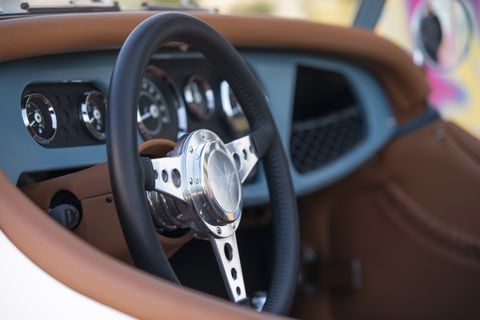
Morgan is probably one of very few British companies that still has a spring in its step during lockdown. The Malvern firm’s first big international launch for the Plus Four has had to be postponed due to the disruption of the pandemic, but you sense the work done just before it temporarily shut up shop was enough to get over the hill, one it had been climbing since the first digital drawings of its ground-breaking CX platform were produced more than four years ago. Along with the Plus Six, the already-popular Plus Four has put Morgan on a totally new path, one that head of design Jon Wells thinks will enable his team to make some pretty bold moves with subsequent products – both aesthetically and technically.
“It’s no secret that we’ve a space at the top of our line-up for an Aero successor,” Wells, a member of the Morgan Cars family for twelve years, tells PH. “Its successor is being worked on and, without giving too much away, we’re prepared to go further than we’ve done before thanks to the flexibility of the CX platform. There’s no monocoque so we’re certainly not tied to one look, we’ve shown with the Plus Four how different the platform can become, and with the BMW engine partnership, we’ve a great supply of powertrains to choose from.”
How does a turbocharged 4.4-litre V8 two-seater to succeed the AeroMax sound? From the tone of his voice on the phone, it seems Wells is on board with the suggestion, but he refrains from getting into the future halo model’s specifics. Right now “it’s about the Plus Four”, he says. Instead, he leaves the door wide open, stating that the “CX platform had flexibility designed into it from the start, so we could use a higher specification of BMW’s modular engines [including the Plus Six’s 3.0-litre B58] or even go down the alternative fuel route. That’s certainly something we know about thanks to the hydrogen fuel cell LIFEcar and EV3 project from a few years back”.
Ah yes, electric. Something not even a brand as firmly tied to tradition as Morgan has been able to avoid. Not that it’s ever wanted to, as the EV3 showed the firm has plenty of ideas when it comes to zero-emission motoring. He says the shelved 2016 model continues to have an impact to this day, with the response to its reveal demonstrating “that people want to see Morgan doing new things for the future”, while “keeping to [its] heritage and remaining a genuine, authentic coach-built car”. The company trained its dealer network to work on EVs so it’s ready to hit the ground running. And, handily for Wells, the packaging freedom offered by an electric car is self evident.
“But when it comes to EVs, we’re making an electric Morgan, not making a Morgan electric,” he affirms. “And there are things that I’d like to retain even the most forward-thinking designs; like the driver will always sit just behind the car’s centre line, behind an A-pillar on the centre and with a dramatic view down the bonnet. That proportion probably stays but beyond that we’re free to play with the Morgan philosophy, so you can expect something to illustrate that it has performance, but without looking too aggressive. How do you maintain the Morgan identity without an intake? We’re thinking about that, with functional design as priority.”
Wells refers to the EV3’s brass fins, there to keep the batteries cool, as an example of EV functionality that’s aesthetically-pleasing and “adds to the car’s story”. He admits that round headlights are likely to remain a staple feature of the Morgan face no matter the powerplant behind them, although new LED technology does allow for variations of the inner details.
The same goes for the wood that mounts to the CX structure, which Wells expects to remain across the board due to the production freedoms it enables, like “actually changing the shape of the car without affecting the platform beneath”. That’s not to say that Morgan wouldn’t consider other things; Wells points to the EV3’s use of sustainably-sourced carbon as evidence of the changes that could be brought about when relevant. But the company needn’t forget about the technical merits of its unique wood-framed engineering.
It does, however, need to consider the potential wider-reaches of its CX platform cars. With improvements to NVH and refinement provided by the aluminium, CAD structure (so no more “pencil and pad sketches”), Wells isn’t the only one expecting the firm’s present customer base – typically men aged between 45 and 60 – to expand. Retro style is at the height of fashion, after all, and Wells is fully aware of a growing hunger for film cameras and vintage clothes, a trend Morgan is well placed to take advantage of. It seems to be going well, despite the impacts of coronavirus; Morgan received record levels of online exposure with the Plus Four, a car the company reckons could become a driver’s favourite thanks to its manual gearbox and one-tonne kerbweight.
“We’re also at a stage now where we can consider future technological and safety regulations before they’re implemented, rather than always reacting as we used to before CX,” Wells says. “We think about pedestrian impacts, which require clear space between the car’s front and engine, and how to place cameras for driver assistance tech, which normally spoils the A-pillar’s lines. And we’ve already proven that we can effectively cool a hot turbocharged engine in what’s a very tight package, while showing that we can make modern wishbone suspension work with a bespoke wire-wheel design. Our pot of technology available for future cars is really very large.”
2020 might not go down in history as a particularly favourable year, but as far as Morgan’s story is concerned, it’s looking like a turning point. Wells says the Plus Four’s enquiry list exceeded expectation, suggesting that once things return to normal, the brand will expect to hit the ground running. Using his enthusiasm as a guide, it’s what’s to come after that which will really get the marque into its 21st century stride. For now, Morgan’s design boss is “itching to get back out on the road for a drive.” We couldn’t agree more.
By Bob Sorokanich, April 6, 2020, https://www.roadandtrack.com/ Photos by Tony Harmer
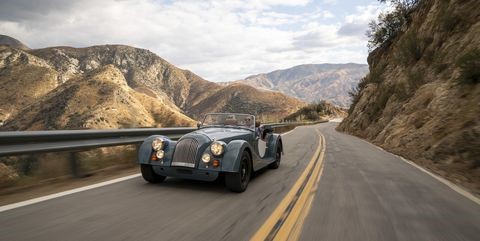
The gamble house is the greatest surviving example of American Arts and Crafts-style architecture, and it was saved by an offhand comment. Completed in 1909, the peak of that building style in Southern California, the house was considered passé by the mid-1940s. The owners wanted to sell the place until someone suggested painting all the woodwork white, “so it won’t be so dark in here.” Instead, they took the house off the market, kept it in the family, and in 1966, gifted it to the city of Pasadena. The residence is now a historic landmark, preserved and maintained by the University of Southern California School of Architecture.
Decades later, we’re in an Arts and Crafts resurgence. The forgotten style is now sought after in antique furniture and original buildings. “It’s lasted more than twice as long in its rediscovery as it did in the first place,” Robert Siminger, a docent at the Gamble House, told me.
The Morgan Plus 4 I parked in the driveway shares something with the residence. Each is of a kind, created to remind us of the joy in simplicity. Introduced in 1950, the Plus 4 was discontinued, revived, canceled, and, in 2005, reintroduced again. Built by a small, family-founded firm in England, the car has been in production as a throwback for longer than it existed as a contemporary design. And now, for the first time in years, you can buy one in the United States, brand-new. A few days before our long weekend with the Plus 4, I showed my girlfriend Natalie a picture of the car, all pouncing fenders and pert headlights. Gumballs on the doors, no bumpers. The perfect air of an old race car, despite the fact that the car is neither a race car nor technically old.
“It’s going to ride terribly,” I warned her. “If it rains, we’re screwed. If it gets cold, we’re screwed. There’s no trunk. The body is made mostly of hope, and it’s all comically unsafe.”
Natalie eyed the Plus 4 the way she looks at Christian Bale. I might as well have been warning her about sunburn while booking tickets for Waikiki. “We’ll be fine,” she scoffed.
We picked the car up at Morgan West, a dealership in Santa Monica, and spent the rest of the day roaming Southern California. Los Angeles is car-blind. Monotonously good weather and an obsession with image make six-figure supercars as common as mailboxes. You go wailing down Sepulveda Boulevard in some carbon-fiber drop-top, nobody bothers to look up from their phone. Not so with the Plus 4. Not since 1968 has the model been an official U.S. import, but it now crosses our border as a “component car,” with a drivetrain in a separate crate and installed upon delivery. Other similarly shaped Morgans (the Plus 8, the 4/4) came to the U.S. in small quantities in the 1980s, 1990s, and early 2000s, but any car from the marque’s small village of Malvern is a rare sight in the States.
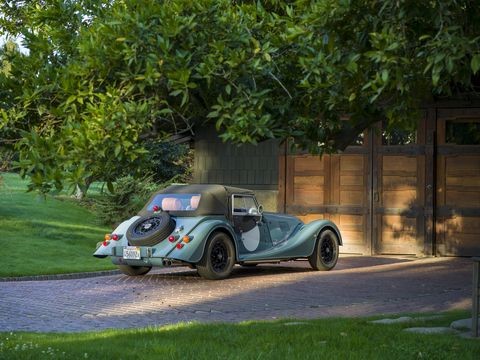
So people stop and gawk. They snap photos and shout questions. The Plus 4 doesn’t project wealth or power. It’s approachable, and it extends that grace to anyone sitting inside. Nobody could be scowly or standoffish in a car with such a wide-eyed, pleasant face.
Or such a small footprint. Photos don’t do justice to the car’s scale. Those sweeping fenders are based on a design Morgan first put into production in the Thirties. They evoke huge, stately coupes á la Cruella De Vil, but the Plus 4 is nine inches shorter and more than a foot narrower than today’s Miata. You sit in the thing like a kayaker, bodywork barely reaching your elbow, looking like you’ve wrapped the hood around outstretched legs. And you drive it with your heels together. The steering wheel and windshield are both about a foot closer than in modern cars, coaxing you into the bent-elbow driving position of prewar racing heroes. The seat snuggles up to the rear axle, inches behind your spine and way behind the car’s longitudinal center. You turn the wheel and watch that long, tapered nose swing into the corner as if you were sitting in the back of a bus.
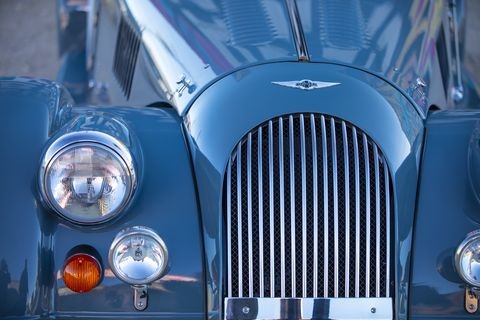
The ride is… taxing. Morgan founder Henry Frederick Stanley Morgan designed his signature sliding-pillar front suspension back in 1909, and the company has since seen little reason to mess with it. Our car, on sport springs, informed us of every dip, sway, and imperfection in the road. On certain stretches of freeway, the Morgan picked up a strong front-to-back seesaw motion. You nod along helplessly, looking like you’re vigorously jamming out to the eighth notes of a hot jazz number.
Bless all of it in its glorious imperfection. It is impossible to drive a Morgan distracted. The manual steering tells you how much weight is on the front axle down to the pound. The firm brake pedal will lock up all four tires on a panic stop. The exhaust thrums like the getaway car in a black-and-white movie. The drivetrain is deeply plebian—2.0-liter, direct-injected, Ford four-cylinder, and a five-speed manual borrowed from an early Miata, 180 horsepower to the leaf-sprung solid rear axle—but sitting down there, low enough to palm the pavement, wind trying to steal your sunglasses, it’s all exhilarating. And unmistakably a product of the nation that birthed Luddites, that launched the Arts and Crafts movement. A sense of keeping the old ways alive with ancient dedication. Writing about the history of the movement in 2002, British architecture historian Alan Crawford said, “Unlike their counterparts in the United States, most Arts and Crafts practitioners in Britain had strong, slightly incoherent, negative feelings about machinery.”
No wonder no other nation produces brand-new cars with structural components made from wood.
In an essay explaining Arts and Crafts at its beginning, the English artist Walter Crane in 1893 described “a protest against the turning of men into machines.” The movement began in Scotland, at the end of the 19th century, as people left their farms and villages to live in cities and work in factories. The labor was often dangerous and always dull, and the products felt cheap and artificial, designed for profitability over functional utility or enjoyment. “The concern that the Arts and Crafts movement was trying to address was that people were becoming ‘alienated from their work,’” Jennifer Trotoux, interim director and curator at the Gamble House, says. “If you were doing just one repetitive thing all day long, you didn’t see the big picture of what you were creating. That was considered an unhealthy mode of work.”
“The whole point of the movement was to go back to a simpler life,” Siminger says. “The house itself was as much a part of the art as the objects within the house.”
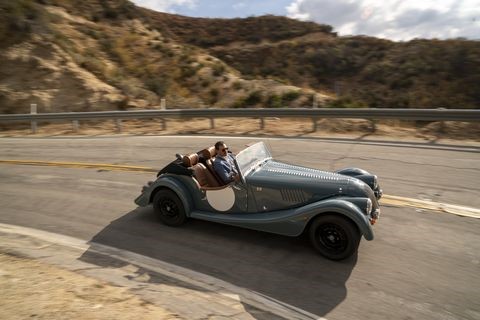
Every visible surface of the Gamble House has thus been shaped and styled by human hands. Huge timbers span the structure, traversing every upstairs room and making the home feel like an upturned wooden ship. The details draw your eye closer until you’re fully consumed by items you wouldn’t give a passing glance anywhere else—the metal straps cinching two joists, the joinery of a picture frame, the way every corner of every brick in a fireplace has been hand-filed to make it friendlier, more approachable. There are no finish nails covered by putty, no joints painted over. Artisans capped every fastener with a contrasting piece of wood. “The house is telling you about itself: ‘This is how I’m held together. This is what I’m made of,’” Trotoux says.
An entire generation of California bungalows have Arts and Crafts touches, but Gamble House luxuriates in the style. Architect brothers Charles and Henry Greene had an unlimited budget to create both the structure and nearly everything inside it. They finished each room in its own exotic wood—mahogany, teak, cedar, fir—with intricate custom furniture to match, all chosen to evoke a particular mood. Aunt Julia’s bedroom, upstairs in the southwest corner, is warm and hushed. The flooring and furniture are made of blond ash—the same flexible, resilient stock found in the Morgan’s wooden framework.
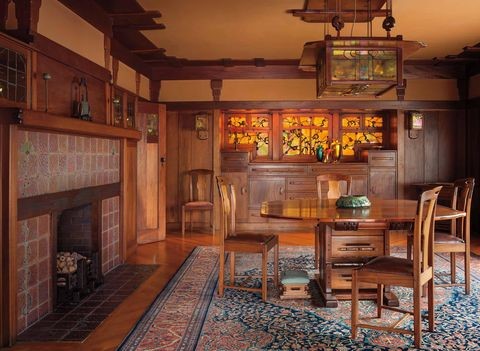
Gamble House cost around $50,000 to build in 1908—roughly $1.4 million in 2019. To recreate it now would take far more. Old-growth exotic woods in these sizes and quantities are basically impossible to come by. Even at the turn of the last century, amassing such a timber collection was virtually unheard of.
And that gets us to an irony. Maybe you recognize the Gamble name—as in Procter & Gamble, the giant industrial manufacturer founded in Cincinnati in 1837, still one of the world’s largest corporations. Ivory soap, and a contract to supply it to the Union Army during the Civil War, made millionaires of P&G’s founders. David Berry Gamble, second-generation, commissioned the California house as a retirement retreat. An architectural movement launched as a rebuke against industrialization came to comfort a man whose name is synonymous with America’s industrial revolution.
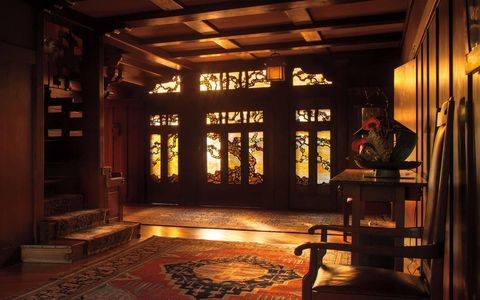
There’s some symmetry here. The Morgan is far from our standard definition of luxury, but with no options, a Plus 4 will run you $70,000. Our test car, loaded, commands $90,000. Door check straps are optional. The Plus 4, like every modern Mog, is clearly meant for occasional use, a plaything for those wealthy enough to spend BMW M4 money on a car built like a shed, and tenacious enough to snag one of the 50 to 100 examples Morgan says it will ship to the U.S. annually.
The car has seen updates, concessions to modernity, but Malvern has been smart enough to keep most of them buried. It took us two days to discover the stereo, a detachable-faceplate head unit tucked under the dash and against the firewall. Reaching the volume knob is like grasping for your shoelace with your seatbelt on. No matter: Wind noise completely drowns out the speakers above 30 mph. And even in sunny Southern California, the car can seem underdressed for the weather. Erecting the mohair top requires two people and a week of steady practice. Still, with the roof closed, the side curtains jabbed into place, and heat blowing from the two swivel vents hidden in the footwells, the Plus 4 is delightfully cozy. The gauges give off the warm sans-serif glow of an old console radio. A cool breeze sneaks in at the rear edge of the door and whispers at your elbow.
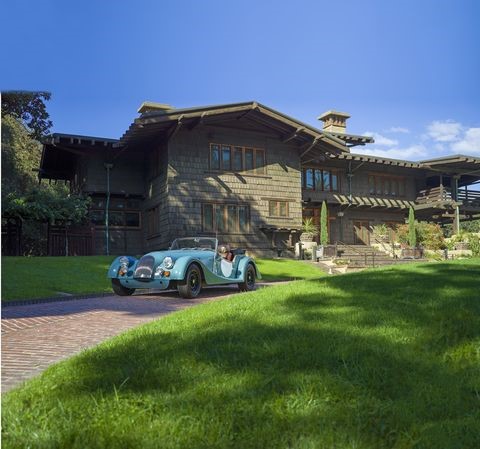
Every good convertible feels like a secret, special place with the roof up—an intimate, slightly clandestine hideout for two people who enjoy each other’s company. The Morgan, its side windows rising only about as high as your nose, reminds you of the joy of being hidden from the world while traveling through it. Somewhere in the middle of the crossover explosion, we forgot that we don’t need acres of glass to operate a motor vehicle. We can simply duck to a low window to check in with the rest of society.
Twenty-first-century luxury yearns to disappear, smooth and seamless, and from a certain perspective, the idea is noble. It banishes ornery design, anticipating every desire. We like to think this frees us to put our minds to greater problems. But the result is domestic amnesia, when you walk into a room and don’t know why you’re there, or when you get to your destination and recall nothing about the drive. Worry behaves like a gas; it expands to fill the space we give it. Short of giving everyone a Gamble House to hide out in, psychologists should prescribe Morgans as therapy.
These are modern problems, of course. To have too much stuff, so cheap and ubiquitous as to be sickening. To be so catered to and comforted as to be anxious. It’s hard to acknowledge these ills without sounding like a spoiled child, surrounded by toys but still not having fun.
Somehow, the auto industry manages to embody both of these diverging traits, cranking out charmless, disposable cars that do most of the thinking for us. And here, we find our brethren. Gamble House docent Robert Siminger drives a wicked little Ford Model A hot rod to give tours of the residence. I chatted with a master carpenter in the driveway as he loaded tools into a small-window 1967 GMC pickup. Several Gamble House volunteers, when they’re not in Pasadena, donate time to the Petersen Automotive Museum, just a half hour away.
Nice to know there are folks like us out there, people who aren’t satisfied by cheap consumerism or cosseting luxury. Artisans keeping the old craftsman ways alive— at home and on the road.